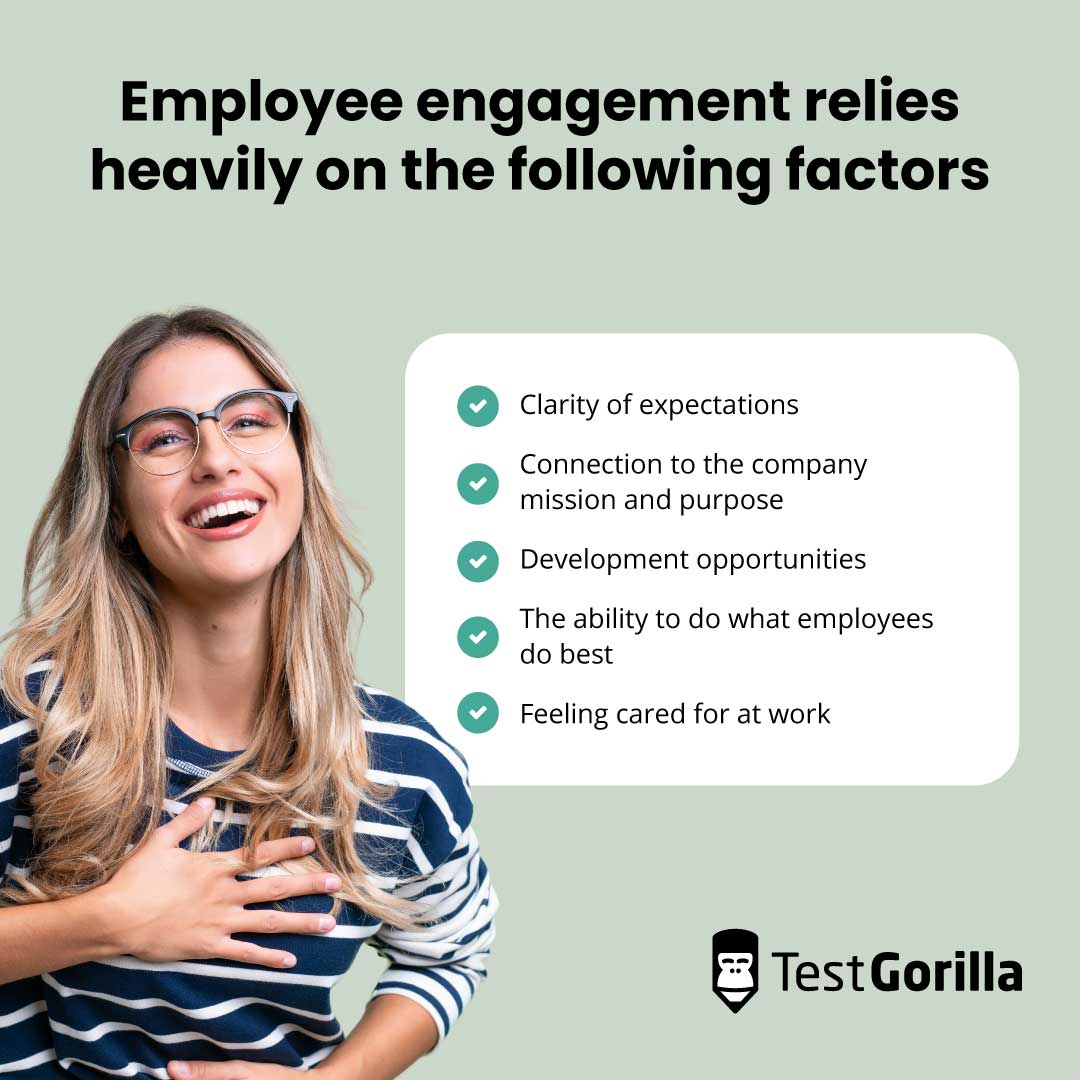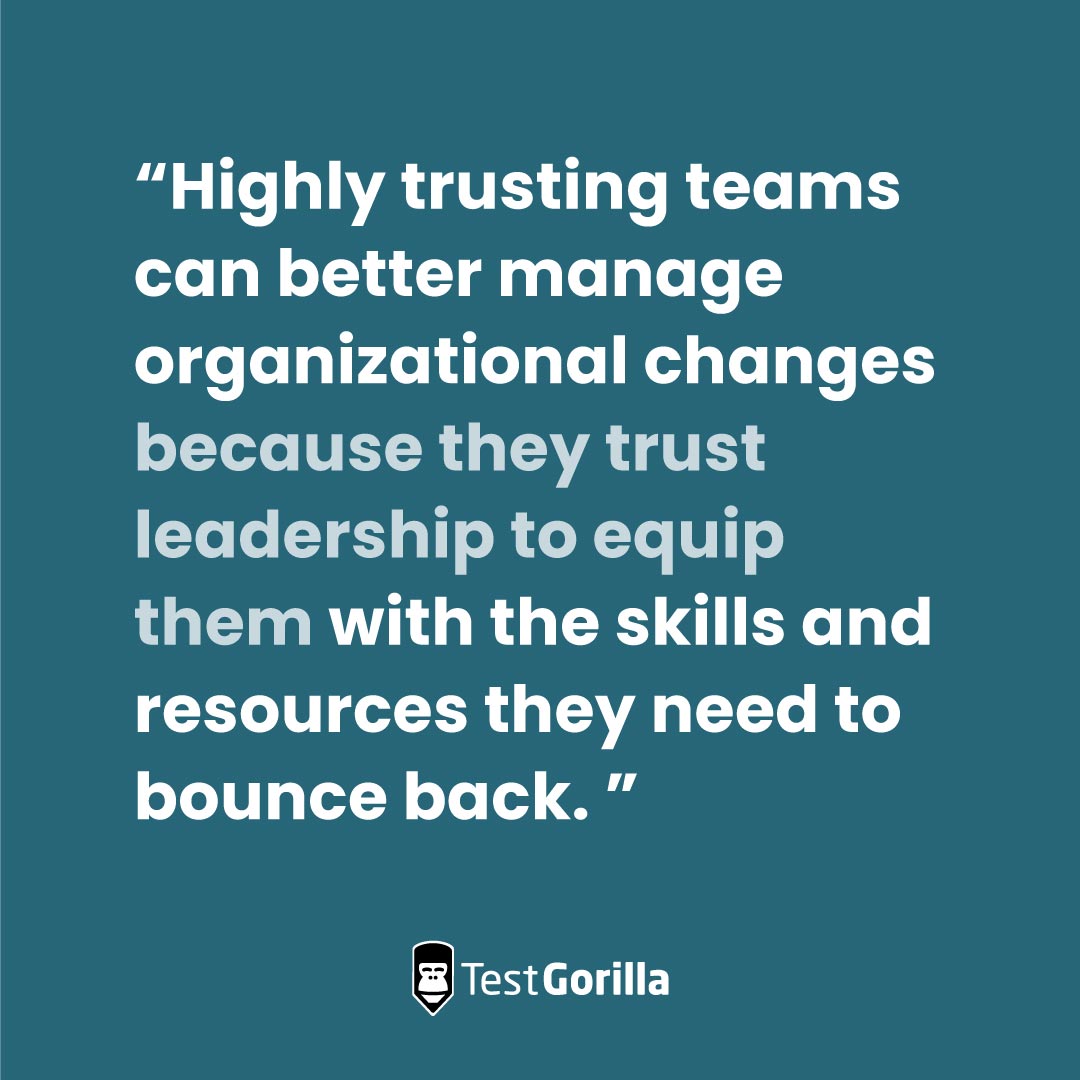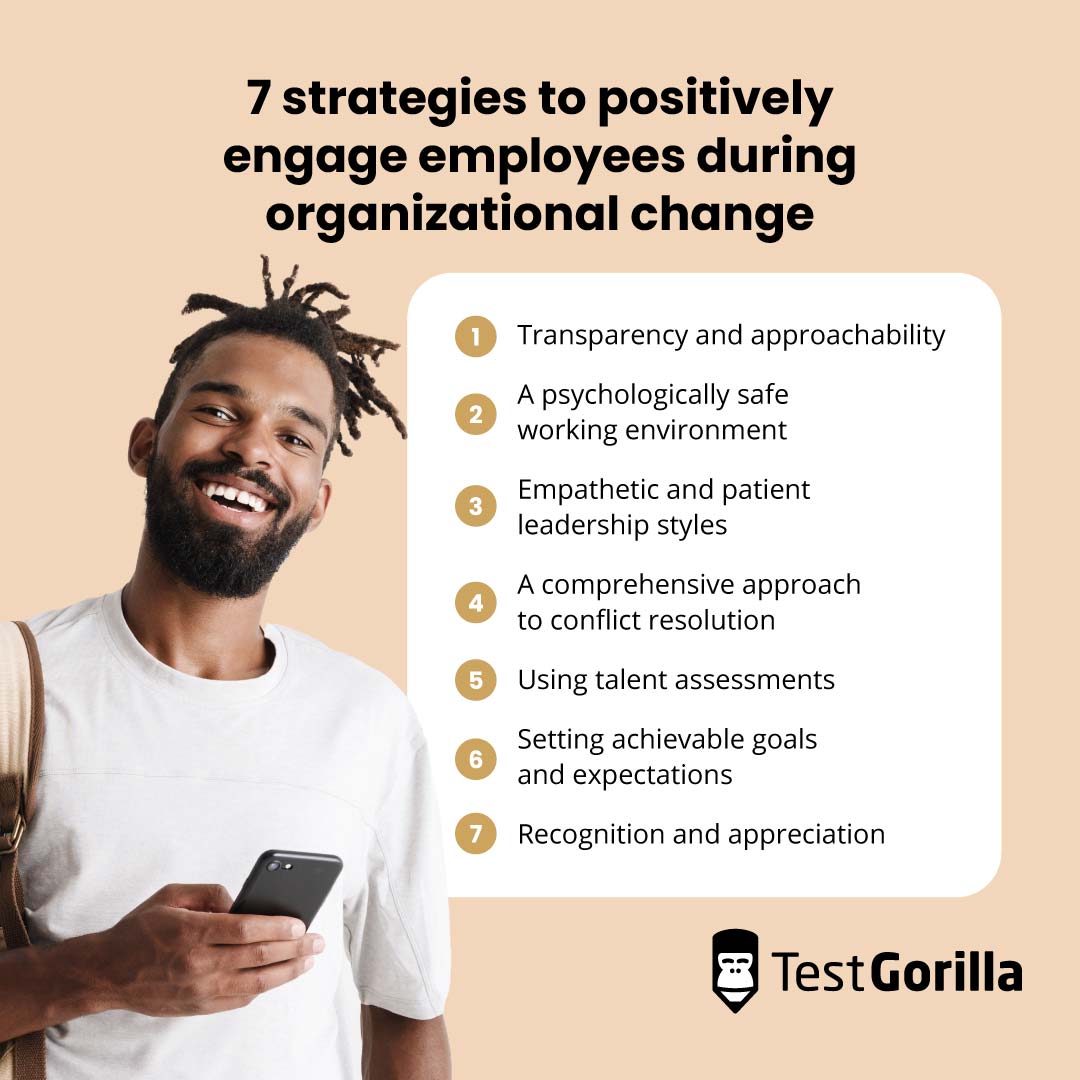How to maintain employee engagement in times of organizational change
Meet Miriam, a software developer at an e-commerce startup. Her CEO just made an important announcement of the launch of 'Project Synergy,' a radical organizational shift that aims to break down hierarchical, isolated departments across the company by creating more cross-functional teams.
Organizational change can have a significant impact on employee well-being and engagement if not managed correctly. In this scenario, Miriam is Muslim and has concerns about clashing with employees from different backgrounds who might not be accepting of her wearing a headscarf.
Employees resisting organizational change can have a domino effect on productivity and performance that can further destabilize your organization.
In this article, we’ll look at the different types of change organizations experience, how they impact employees and engagement, mistakes to avoid, and strategies to properly manage change.
Additionally, we'll explain how to use talent assessments to hire and develop the skills leaders need to successfully navigate change and manage employee engagement and motivation. With skilled leadership, Miriam can join her new cross-functional team feeling supported, and create new workplace friendships.
Understanding employee engagement and how to nurture it
Understanding employee engagement goes beyond simply measuring job satisfaction or productivity. It’s all about the emotional commitment, enthusiasm, and sense of purpose employees bring to their work.
Research by Gallup shows that employee engagement relies heavily on the following factors:
Clarity of expectations
Connection to the company mission and purpose
Development opportunities
The ability to do what employees do best
Feeling cared for at work[1]
This means, engaging employees depends on your ability to communicate their purpose and how it plays into the company's vision. It also means navigating organizational change transparently to keep employees feeling secure.
Below, we explore why this is important.
The impact of organizational change on your teams
Big company changes can be positive and negative for your teams, depending on how that change is managed and implemented. Done poorly, it can cause disruption and uncertainty, which can have a negative psychological impact.
When teams are unsure about their roles, responsibilities, or the future direction of the company, it can affect their performance and job satisfaction.
Changes in personnel, hours, strategy, roles, tools, and working conditions can all take a mental and emotional toll on your people and affect engagement.
According to Jon Morgan, chief executive at VentureSmarter: "One of the biggest mistakes is underestimating the emotional impact of change. Leaders should acknowledge employees' concerns and provide emotional support while trying to involve them in the change process."
However, organizational change can also bring increased efficiency to old processes and often requires employees to learn new skills or adapt existing ones. For example, in Miriam's case, the introduction of cross-functional teams helps promote collaboration and knowledge sharing in her company.
This can be an opportunity for team members to grow and develop professionally, which can boost job satisfaction and long-term career prospects.
Case study: Elon Musk and X
In October 2022, Elon Musk officially took Twitter private and became the company’s majority shareholder. He appointed himself CEO and brought in his own team to clean house: He laid off 80% of the staff, changed the company's name to "X," and slashed unprofitable departments.
These rapid organizational changes came as a shock for employees, leaving morale, engagement, and company culture in the dust. In a survey conducted one week after the layoffs, only 2% of Twitter employees said they’d recommend the workplace to their friends or family. Moreover, just 1% said the recent layoffs had been carried out in a respectful and empathetic manner.
Once the damage is done, even if the company is financially profitable, it can take years to rebuild a strong company culture that people want to be part of. For example, lasting negative effects at X include a culture of sleeping in the office and making a ghost town of what used to be a bustling Slack channel.
The consequences of having unengaged employees
Employee engagement is strongly linked to improved performance outcomes such as employee retention, customer loyalty, and productivity. The connection between employee engagement and performance also becomes more important during tough economic times.[2]
This means that having an engaged team makes your company more resilient and adaptable to unpredictable market shifts. On the other hand, when employees aren't engaged, they can be more likely to suffer from burnout and stress. This is associated with mental and physical health issues and lower productivity.
Research shows that employee disengagement amounts to $8.8tn in untapped productivity for global workplaces.[2] Therefore, companies that prioritize and invest in strategies to boost employee engagement can unlock significant productivity gains and foster a more positive work culture.
Shifting the focus from change to positive engagement
When you focus on positive engagement rather than the change itself, you can improve the resilience and well-being of your workforce. This is because engagement involves elements of caring, development, communication, collaboration, and involvement, which set the stage for developing trust.
Highly trusting teams can better manage organizational changes because they trust leadership to equip them with the skills and resources they need to bounce back.
The best insights on HR and recruitment, delivered to your inbox.
Biweekly updates. No spam. Unsubscribe any time.
Overcome the resistance: 7 strategies to positively engage employees during organizational change
Creating a culture of engagement and trust during times of organizational change starts with the leadership approach and continues with skills, all within clear guidelines.
Let's examine what that involves:
1. Transparency and approachability
The way leaders manage their teams can set the tone for everyone's ability to engage and build a supportive culture.
It's important for leaders to be transparent and approachable during turbulent times to inspire people to turn to them and each other for support. Otherwise, employees might simply “check out” or internalize their stress.
Here's what leaders should do:
Provide regular updates. Regular communication helps keep everyone aligned on organizational changes and goals and can help smooth over any questions, concerns, or doubts.
Offer opportunities for feedback, including feedback on leadership. This should be a continuous process and exchange. Make it clear that people can leave unsolicited feedback anytime, on your specified, anonymous feedback channels or in 1:1s.
Be prepared. Big announcements or changes should be revealed weeks if not months in advance to help your people adjust. You should also be ready at the time of your announcement to give people actionable advice or answers before they ask for it.
Hold open office hours and 1:1s. "Open office" slots allow anyone to show up and chat informally with leaders, which can give people the reassurance they need before, during, or after organizational shifts.
2. A psychologically safe working environment
Prioritizing psychological safety allows everyone on your team to speak up and be themselves without fear of judgment or negative consequences. This can make or break your team's ability to adjust to big company changes: If employees aren't feeling safe or comfortable to begin with, the shift might sink that already-rocking boat entirely.
Here are a few ways to promote a psychologically safe working environment:
Celebrate wins. Encourage people to shout each other out on Slack or in team meetings. This boosts motivation and inspires other employees to put in their best efforts.
Get everyone involved. Invest in team-building activities and events that help employees build trust and strengthen their relationships.
Provide flexibility. Offer flexible work arrangements when possible to accommodate employees' needs, including work-life balance. This can reduce stress and improve employee loyalty.
Promote inclusivity. Make sure everyone's voice is heard and that you're creating equal opportunities for people to participate in the decision-making process.
Support mental health. Conduct regular check-ins with employees to gauge their well-being and job satisfaction. Encourage self-care and destigmatize seeking help for mental health issues.
3. Empathetic and patient leadership styles
Empathy in the workplace can lead to greater productivity and positive work experiences. In fact, employees with empathetic leadership are more innovative and committed to their team.
Fifty percent (50%) of employees with empathetic leaders report having an inclusive work environment, compared to only 17% of people with less empathetic leaders.[3]
To drive productivity and engagement through empathetic leadership:
Use talent assessments to develop skills. Hire and develop the right leaders by testing for soft skills that promote approachability and transparency, like empathy, communication, and active listening.
Practice active listening and patience. Pay full attention to what others are saying and ask clarifying questions to make sure you understand their perspective. Also, know that not everyone works at the same pace or grasps concepts as quickly as others.
Lead by example. Handle conflicts or obstacles with patience and empathy. Seek to understand the underlying causes of problems before addressing them.
Support employee growth. Provide opportunities for professional development and skill-building. Additionally, be patient with employees as they develop new skills or take on new responsibilities.
Emphasize self-care. Recognize the importance of self-care practices. This can also help you manage your own stress and emotions to prevent them from negatively affecting your leadership.
4. A comprehensive approach to conflict resolution
Conflict resolution is all about constructive dialogue and compromise, which are skills you need to develop to address and resolve conflicts effectively.
Here's how:
Recognize and acknowledge the conflict. Acknowledge that conflict exists and that it needs to be addressed. Avoiding or denying conflict can make it worse – active listening is especially useful here.
Have a private conversation. Conduct a private and confidential discussion with the involved parties. This allows them to express their concerns without fear of embarrassment or retaliation.
Practice empathy and stay calm. Show empathy by acknowledging the emotions and concerns of everyone involved. Even if you don't agree with their perspective, validating their feelings can help build rapport.
Brainstorm and evaluate solutions. Encourage all parties to brainstorm potential compromises and solutions to the conflict with a sense of creativity and open-mindedness.
Third-party involvement. If the conflict is particularly complex or involves deeply-rooted issues, consider involving a neutral third party to facilitate the resolution process. This can be a mediator, HR representative, or trusted colleague.
Training and prevention. Provide conflict resolution training and interpersonal communication skills to employees to prevent future conflicts and give them the tools to resolve conflicts independently.
5. Using talent assessments
"Providing training and development opportunities to equip employees with the skills needed for the new environment is essential. Soft skills might include adaptability, open-mindedness, effective communication, and the ability to collaborate. These skills help employees remain flexible and receptive to change, fostering a positive environment for innovation." – Jon Morgan, chief executive at VentureSmarter.
Talent assessments allow you to measure and develop the soft skills employees and leaders need to navigate organizational change.
When you take a skills-based approach to hiring, reskilling, and upskilling talent, it's easier to spot skills gaps and opportunities for development and, thus, retain top talent.
You can evaluate soft skills using these tests:
Once you determine the skills people have, you can move on to those that can be taught, for better alignment across roles and teams. If you're restructuring your company, skills-based assessments can help you create cross-functional teams that complement each other in their applied skills, to help fill any gaps.
Skills-based assessments also improve employee engagement: According to our 2024 State of Skills-Based Hiring report, 91% of employers that use skills-based hiring improve retention.
Pro tip: Check out our test library for tests that let you spot potential leaders on your team, as well as those who are adaptable and have the soft skills to navigate change and boost employee engagement.
6. Setting achievable goals and expectations
In times of change, you need to set achievable goals and expectations as part of your internal communication strategy.
Unrealistic or overly ambitious goals can lead to frustration and burnout, while achievable goals provide motivation and a sense of accomplishment.
For example, setting a goal to double sales revenue overnight for a sales team adjusting to a new pricing model would be unrealistic – and negatively impact morale.
Here's how to set goals that inspire engagement in your team:
Involve your team. Encourage everyone to provide input and insights on how the team can adapt to the changes effectively, and make decisions together.
Define clear objectives. Set specific, measurable, achievable, relevant, and time-bound (SMART) objectives for your team. Ensure that these objectives align with the broader reasons for the organizational change.
Break down large goals into smaller, manageable tasks. This makes the goals more achievable and allows team members to track progress more effectively.
Set realistic expectations. Be realistic about what can be accomplished within the given time frame. Avoid overloading your team with unrealistic expectations that may lead to a lack of trust or burnout.
Regularly communicate progress. Keep the lines of communication open by providing regular updates on the team's and company's progress toward its goals. Share successes and challenges along the way.
Adjust goals as needed. Be flexible and open to adjusting goals and expectations if the organizational change evolves or if unforeseen challenges arise.
7. Recognition and appreciation
"Recognizing and rewarding employees for their efforts and adaptability during change can improve morale and motivation," Jon says.
By showing your team you acknowledge any sacrifices and adjustments they've made, you're reaffirming their decision to stay with the company – mentally and physically.
Here's how:
Celebrate both personal and professional milestones like work anniversaries, birthdays, and project successes. Small gestures like a cake or e-card can go a long way.
Implement a reward program to recognize outstanding performance. This could include bonuses, gift cards, or free lunches.
Encourage peer recognition. Enable team members to recognize and appreciate each other's contributions. Properly managed, peer-to-peer feedback can also help improve communication among team members and strengthen bonds.
Use the element of surprise. Occasionally, surprise team members with unexpected recognition or rewards during all-hands meetings or on Slack. These spontaneous acts of appreciation can change the course of your people's day.
Offer feedback. Provide constructive feedback that helps team members grow and improve. Make sure to recognize their efforts to learn and develop their skills.
Focus on skills to maintain employee engagement in times of change
Organizational change can naturally be scary for employees. However, if properly managed, it can inspire employees to develop new skills, clearly communicate their needs, and form new relationships.
When you keep employee engagement top of mind during these transitions, you can build an adaptable team and company culture people truly want to be part of.
Engage your employees during organizational change by being transparent and approachable, taking a comprehensive approach to conflict resolution, and setting achievable goals and expectations, to name a few.
You can also use talent assessments to hire and develop resilient employees and leaders with the right skills for managing – and thriving – in times of change.
Want engaged employees who are ready for anything?
Talent assessments help you hire and develop talent with the right skills to navigate change.
Read the State of Skills-Based Hiring 2024 to learn more.
Sources:
"U.S. Employee Engagement Needs a Rebound in 2023." (2023). Gallup. Retrieved September 15, 2023. https://www.gallup.com/workplace/468233/employee-engagement-needs-rebound-2023.aspx
"Globally, Employees Are More Engaged — and More Stressed." (2023. Gallup. Retrieved September 15, 2023. https://www.gallup.com/workplace/506798/globally-employees-engaged-stressed.aspx
"The Power of Empathy in Times of Crisis and Beyond." (n.d.) Catalyst. Retrieved September 15, 2023. https://www.catalyst.org/reports/empathy-work-strategy-crisis
Related posts
You've scrolled this far
Why not try TestGorilla for free, and see what happens when you put skills first.

















